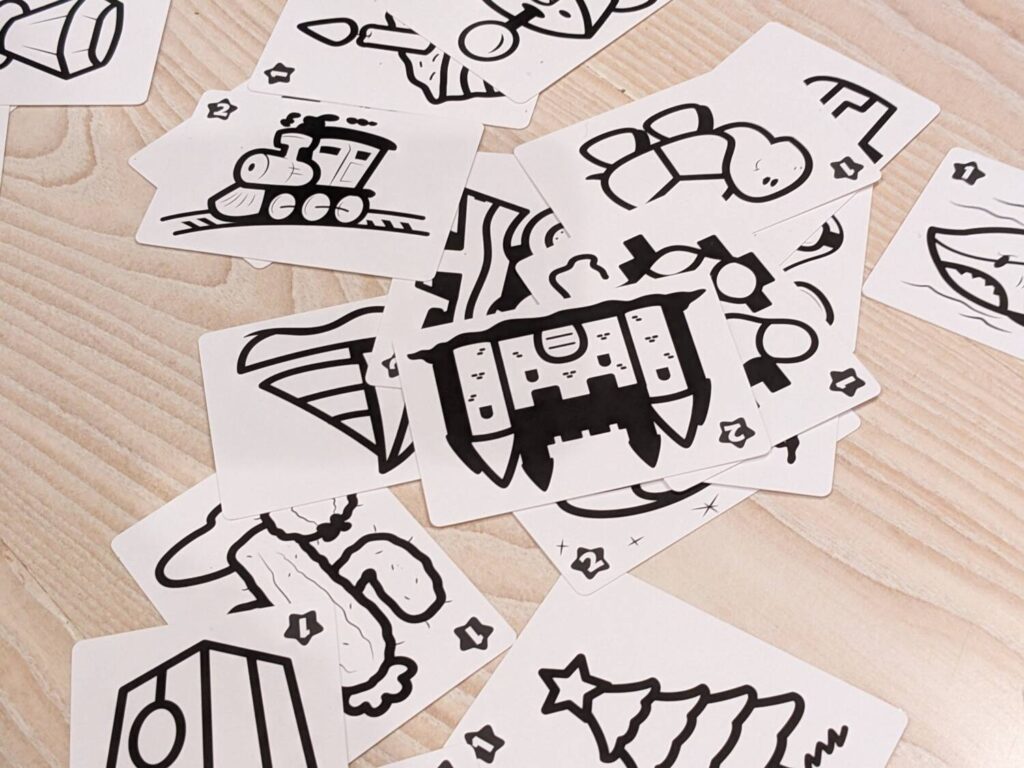Disclosure: Meeple Mountain received a free copy of this product in exchange for an honest, unbiased review. This review is not intended to be an endorsement.
During a recent trip to the beach, I brought a boatload of my Gen Con 2024 party and family game pickups to our rental property in the hopes that I could get some of them to the table.
Speed Colors (2017, currently published by Friendly Skeleton, the new name for Deep Water Games) was a game I was excited to play thanks to a quick demo with Beneeta Kaur, the marketing rep for Friendly Skeleton. Even during that 10-minute demo, I could tell Speed Colors would be a winner with my kids…and after three more plays at the beach (all at the max five-player count), I’m glad to say I was right.
Speed Colors has a very simple setup. Each player selects a white-and-black outlined card from the pool to color, then a player yells “go!” and everyone flips their card over to its colored side. Each picture has six colored areas (red, blue, yellow, orange, green, purple), so the goal is to memorize the correct locations of each color in each section of the card, then flip the card back to its non-colored side and color in all six sections as quickly as possible with the correct colors.

But, there is one other issue—there are only six markers for all players to share, so grabbing the color you need while trying to remember the right locations for each shade leads to the kinds of party-game chaos I enjoy. When one player completes their picture, they yell “stop!” and all other players get to finish a section of their card if they are holding a marker when the round ends.
Scoring is straightforward. The big thing in Speed Colors is coloring within the lines. If your coloring bleeds over the edge of a section, that section of the card is worth zero points. Even if a player colors a section well but uses the wrong color, they still get a point, and they get a bonus point for every section that matches the right color on the original colored picture. That means the best score for a card is 12 points: six points for coloring in all six sections, and six more points if the colors match the original image.
Speed Colors goes for four rounds, and the player with the most points wins. In our games, we played until someone scored 48 points, which was always around five rounds.

Better With the Kids
The adults who joined me for Speed Colors left with mixed feelings. “It was OK,” said one adult player. “It was fun to watch the kids race to color everything in first.”
Another sat for part of a full game then asked for another person to substitute into the game for their seat. “Not bad,” that person said. Then she went off and looked at her phone while I kept playing with the sub and three other kids (ages 9, 9 and 10).
I enjoyed Speed Colors but after a few plays, I realized that I enjoyed Speed Colors more because my 10-year-old loved playing so much. It was a blast to sit with them and play for 45 minutes (well past the end of the main game) because they wanted to keep testing themselves by drawing on all the cards.
In that way, Speed Colors was fun but I don’t think it has the legs that other party games have in our house. In an interesting twist, a different Deep Water Games product—2020’s MonsDRAWsity—is our family’s go-to drawing game and my seven-year-old brought this up while watching a game of Speed Colors.
Some of those legs come from the sheer number of cards in MonsDRAWsity. There are a hundred cards in the base game alone, with multiple expansions that extend the journey.
Speed Colors is a little light on cards (55), and though one assumes that people couldn’t memorize the colors on the back of each card, it’s surprising that there are so few cards in the box. There’s also a co-op mode but even throwing out the idea of co-op to the kids led them to stick with competitive mode for our time at the beach.
I enjoyed Speed Colors. As I finished this review, the game remained on the large game/puzzle table near the beach rental’s dining room. It’s great that the kids have used Speed Colors both as a game and as an activity…and, anything that’s not on a screen is an activity I can get behind!












Add Comment